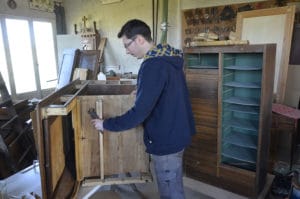" I have a particular link to heritage. I do a lot of restoration work, both on listed or classified heritage - for churches in particular - and on popular heritage, such as the restoration of antique furniture for private individuals. It is a type of heritage that is not officially considered, but which is also part of history and constitutes a heritage in its own right. It is a local, family heritage. On another note, I have always appreciated the fact that I can visit castles and churches. I can't imagine living without these historic buildings, without them being part of the landscape. "Sylvère Grandvoiennet, cabinetmaker and heritage restorer
With a long experience in the restoration of wooden objects listed or classified as Historic Monuments, the furniture of the factory as well as that of the mansion of the Alexis Le Gall cannery museum were entrusted to the expert care of Silvère Grandvoinnet, a cabinetmaker trained by the Compagnons du Devoir and now self-employed in his workshop in Saint-Guénolé-Penmarc'h. Accustomed to restoring religious furniture or furniture from family heirlooms, the treatment of the tables and benches of the cannery has allowed him to discover a new aspect of popular heritage, whose human dimension shines through the traces left by the years of work of canning. He agreed to talk to us about the challenges of such a restoration.
his background professional
After a literary baccalaureate, I started a CAP (vocational training certificate) in carpentry in Brest with the Compagnons du Devoir. At the same time, I took a professional certificate in carpentry and a CAP in sculpture. I then went on a four-year tour of France. When I finished my tour in 2014, I decided to set up my own business in Guilvinec. Two years ago, I had the opportunity to buy this workshop in Saint-Guénolé-Penmarc'h.
its notion of heritage
I have a particular link to heritage. I do a lot of restoration work, both on listed or classified heritage - for churches in particular - and on popular heritage, such as the restoration of antique furniture for private individuals. It is a type of heritage that is not officially considered, but which is also part of history and constitutes a heritage in its own right. It is a local, family heritage. For almost a year, I have also had a partnership with a shop in which I work on another aspect. I make old elements, reconstructions of spoons, knives, three-legged stools. These things are part of a heritage that is tending to be recognised again because it is not manufactured. On another note, I've always appreciated the fact that I can visit castles and churches. I can't imagine living without these historic buildings, without them being part of the landscape.
Its role in the of the museum project
On the Alexis Le Gall cannery site, I work on the wooden furniture of the collection. My work concerns the factory furniture such as work tables (trimming, casing, oiling), benches and wooden crates. I am also in charge of restoring the furniture of the manor house, such as Alexis Le Gall's old office. These two tasks are different in the sense that they do not require the same treatment or the same technical skills. The wooden objects in the factory consist of relatively rough joinery such as nailed fir planks, whereas the furniture in the mansion is more finely crafted cabinetwork.
its great challenges
The most complicated part of this task is that the vast majority of the furniture is old. When you look at some of the items at first glance, you might think that they are beyond repair. The challenge was therefore to find the right balance between a complete restoration that goes into detail and finishes - using varnish and erasing the traces of time - and a lighter restoration that respects the history of the object and leaves the traces of its life visible. The restoration should not give the impression that the object is new.
When I took over the worktables at the factory, some of them had up to 20 centimetres of hollow because the legs were eaten away. In this context, the restoration consisted of putting pieces of wood under the legs to straighten the structure. The question is: how far can the modern element be integrated with the ancient object? What is relevant to keep? You have to make choices.
There are wooden elements that are completely rotten, but they are the witness of many human lives. The other day I came across a bench with a completely rotten surface, but with a name legibly engraved on the surface. So if you look up the name in the museum's archives, you can find out who the worker was who put her name on the bench. If I had decided to sand and plane this bench to make it look more attractive again, the writing would simply have been lost.
It's the same with the oil bins. On some of them, there are chalk inscriptions. We must keep these testimonies. On one of the oiling tables, under the zinc, there is oil that has completely congealed over time, after decades of use of the table. It is a trace with a strong symbolic significance, hence the question of the balance between restoring a certain aesthetic to these objects, without completely erasing the traces of wear which are in themselves a testimony to the past.
its best souvenir
The other day I went to the cannery. Opposite the rue de la Grandière, at the intersection with the rue du port, there is a small car park where photographs from the time when the factory was still in operation are on display, showing the workers at work in the premises. There I saw the furniture I am restoring. Seeing them in their context of use, when they were still in operation, triggered a very strong feeling in me. Usually, in my heritage work, I am faced with objects that are representative of the life or achievements of a great man, or objects that are officially recognised by the state because the object in question is 'worth seeing' from a visual point of view. In the case of the furniture in the cannery, we are dealing with raw fir wood. When I restore it, I discover as I go along the traces of knives on it, the history of these objects that have been used and that transport me back in time to the women who worked in the factory. The visual traces, whether photographs or inscriptions on the wooden furniture, reinforce this feeling of link, of historical continuity.


